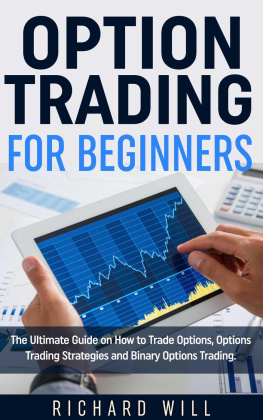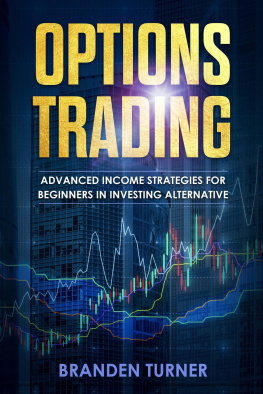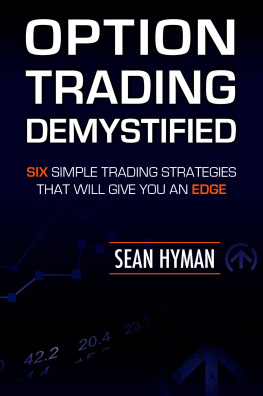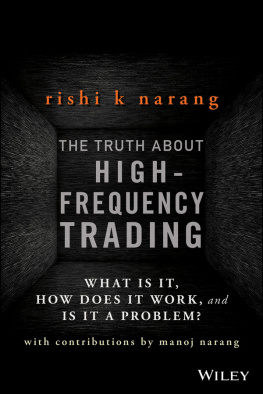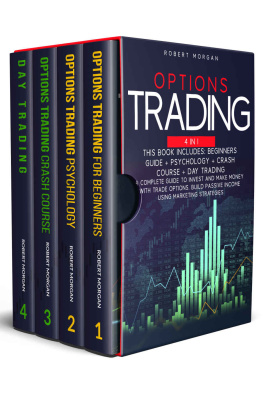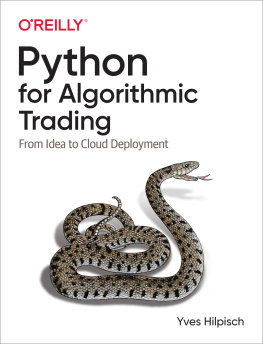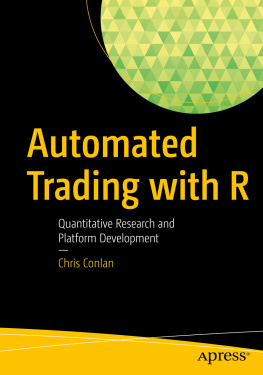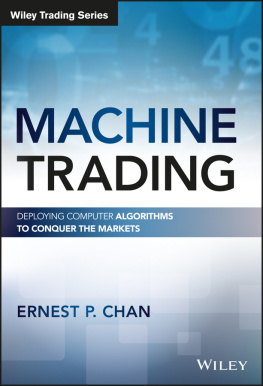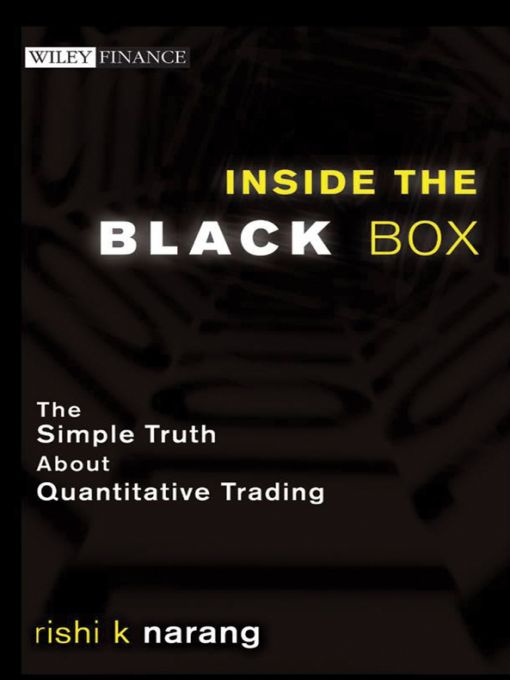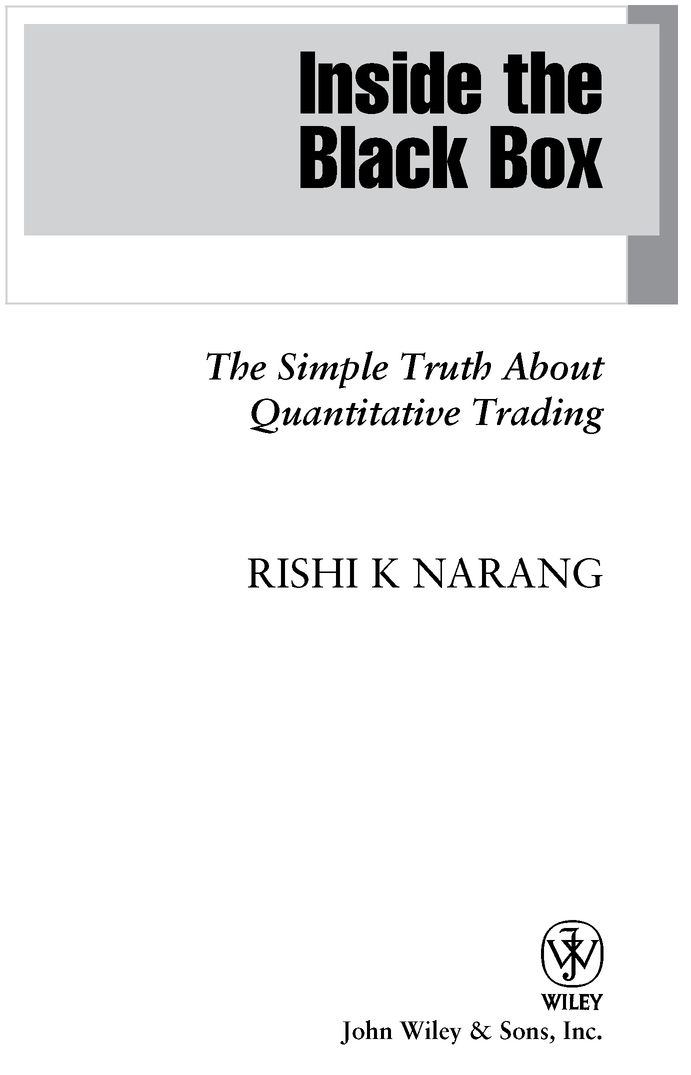Table of Contents
Founded in 1807, John Wiley & Sons is the oldest independent publishing company in the United States. With offices in North America, Europe, Australia and Asia, Wiley is globally committed to developing and marketing print and electronic products and services for our customers professional and personal knowledge and understanding.
The Wiley Finance series contains books written specifically for finance and investment professionals as well as sophisticated individual investors and their financial advisors. Book topics range from portfolio management to e-commerce, risk management, financial engineering, valuation and financial instrument analysis, as well as much more.
For a list of available titles, visit our web site at www.WileyFinance.com.
This book is dedicated to my father and mother, Thakur and Krishna Narang, to whom I owe so much, and to my wife and partner of many years, Carolyn Wong, whose love and support make a hell of a lot of things really a lot better.
Preface
An unnecessary opaqueness surrounds quantitative trading strategies (known to many as black boxes), despite their importance to the capital markets and the sensational, widely known examples of their successes and failures. This opaqueness, which quants themselves frequently perpetuate, exacerbates an already widespread misunderstanding of quantitative trading in the broader investment community.
This book takes you on a tour through the black box, inside and out. It sheds light on the work that quants do, lifting the veil of mystery that surrounds quantitative trading and allowing those interested in doing so to evaluate quants and their strategies.
The first thing that should be made clear is that people, not machines, are responsible for most of the interesting aspects of quantitative trading. Quantitative trading can be defined as the systematic implementation of trading strategies that human beings create through rigorous research. In this context, systematic is defined as a disciplined, methodological, and automated approach. Despite this talk of automation and systematization, people conduct the research and decide what the strategies will be, people select the universe of securities for the system to trade, and people choose what data to procure and how to clean those data for use in a systematic context, among a great many other things. These people, the ones behind quant trading strategies, are commonly referred to as quants or quant traders.
Quants employ the scientific method in their research. Though this research is aided by technology and involves mathematics and formulae, the research process is thoroughly dependent on human decision making. In fact, human decisions pervade nearly every aspect of the design, implementation, and monitoring of quant trading strategies. As it turns out, quant strategies and traditional discretionary investment strategies, which rely on human decision makers to manage portfolios day to day, are rather similar in what they do.
The differences between a quant strategy and a discretionary strategy can be seen in how the strategy is created and in how it is implemented. By carefully researching their strategies, quants are able to assess their ideas the same way that scientists test theories. Furthermore, by utilizing a computerized, systematic implementation, quants eliminate the arbitrariness that pervades so many discretionary trading strategies. In essence, decisions driven by emotion, indiscipline, passion, greed, and fearwhat many consider the key pratfalls of playing the marketare eliminated from the quants investment process. They are replaced by an analytical and systematic approach that borrows from the lessons learned in so many other fields: If something needs to be done repeatedly and with a great deal of discipline, computers will virtually always outshine humans. We simply arent cut out for repetition in the way that computers are, and theres nothing wrong with that. Computers, after all, arent cut out for creativity the way we are; without humans telling computers what to do, computers wouldnt do much of anything. The differences in how a strategy is designed and implemented play a large part in the consistent, favorable risk/reward profile a well-run quant strategy enjoys relative to most discretionary strategies.
To clarify the scope of this book, it is important to note that I focus on alpha-oriented strategies and largely ignore quantitative index traders or other implementations of beta strategies. Alpha strategies attempt to generate returns by skillfully timing the selection and/or sizing of various portfolio holdings; beta strategies mimick or slightly improve on the performance of an index, such as the S&P 500. Though quantitative index fund management is a large industry, it requires little explanation. Neither do I spend much time on the field of financial engineering, which typically plays a role in creating or managing new financial products (e.g., CDOs). Nor do I address quantitative analysis, which typically supports discretionary investment decisions. Both of these are interesting subjects, but they are so different from quant trading as to be deserving of their own, separate discussions carried out by experts in those fields.
This book is divided into three parts. Part One (Chapters 1 and 2) provides a general but useful background on quantitative trading. Part Two (Chapters 3 through 9) details the contents of the black box. Part Three (Chapters 10 through 13) provides an analysis of quant trading and techniques that may be useful in assessing quant traders and their strategies.
It is my aspiration to explain quant trading in an intuitive manner. I describe what quants do and how they do it by drawing on the economic rationale for their strategies and the theoretical basis for their techniques. Equations are avoided, and the use of jargon is limited and explained, when required at all. My aim is to demonstrate that what many call a black box is in fact transparent, intuitively sensible, and readily understandable. I also explore the lessons that can be learned from quant trading about investing in general and how to evaluate quant trading strategies and their practitioners. As a result, Inside the Black Box may be useful for a variety of participants in and commentators on the capital markets. For portfolio managers, analysts, and traders, whether quantitative or discretionary, this book will help contextualize what quants do, how they do it, and why. For investors, the financial media, or anyone with a reasonable knowledge of capital markets in general, this book will engender a deeper understanding of this niche.
RISHI K NARANG
Acknowledgments
This book would not be readable without the untiring editing of Arzhang Kamarei. My colleagues at Telesis Capital, Myong Han and Yimin Guo, similarly read through countless revisions of this text and offered many invaluable and timely suggestions. I am grateful to Sudhir Chhikara, one of the brightest quants I know, for taking the time to read Inside the Black Box and provide many constructive criticisms. Id also like to thank Aaron and Sandor Straus of Merfin LLC for their help with the Data chapter.
I am indebted to my brother, Manoj Narang, from whom I have learned so much. Vijay Prabhakar provided many helpful suggestions and answers to questions related to machine learning, as Rick Durand did with the subject of optimization.


